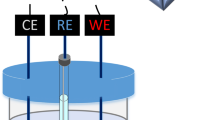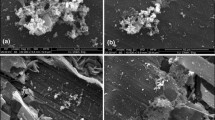Abstract
Biofilms were used to produce gramicidin S (a cyclic decapeptide) to inhibit corrosion-causing, sulfate-reducing bacteria (SRB). In laboratory studies these biofilms protected mild steel 1010 continuously from corrosion in the aggressive, cooling service water of the AmerGen Three-Mile-Island (TMI) nuclear plant, which was augmented with reference SRB. The growth of both reference SRB (Gram-positive Desulfosporosinus orientis and Gram-negative Desulfovibrio vulgaris) was shown to be inhibited by supernatants of the gramicidin-S-producing bacteria as well as by purified gramicidin S. Electrochemical impedance spectroscopy and mass loss measurements showed that the protective biofilms decreased the corrosion rate of mild steel by 2- to 10-fold when challenged with the natural SRB of the TMI process water supplemented with D. orientis or D. vulgaris. The relative corrosion inhibition efficiency was 50–90% in continuous reactors, compared to a biofilm control which did not produce the antimicrobial gramicidin S. Scanning electron microscope and reactor images also revealed that SRB attack was thwarted by protective biofilms that secrete gramicidin S. A consortium of beneficial bacteria (GGPST consortium, producing gramicidin S and other antimicrobials) also protected the mild steel.







Similar content being viewed by others
References
Anonymous (1998) Multiple-tube fermentation technique for members of the coliform group. In: Greenberg AE, Clesceri LS, Eaton AD (eds) Standard methods for the examination of water and wastewater. American Public Health Association, American Water Works Association, and Water Environment Federation, New York, 9-45–9-51
Azuma T, Harrison GI, Demain AL (1992) Isolation of a gramicidin S hyperproducing strain of B. brevis by use of a fluorescence activated cell sorting system. Appl Microbiol Biotechnol 38:173–178
Beloglazov SM, Dzhafarov ZI, Polyakov VN, Demushin NN (1991) Quaternary ammonium salts as corrosion inhibitors of steel in the presence of sulfate-reducing bacteria. Prot Met (USSR) 27:810–813
Borenstein SW (1994) Microbiologically influenced corrosion handbook. Woodhead, Cambridge, England
Chen M, Nagarajan V (1993) The role of signal peptide and mature protein in RNase (barnase) export from Bacillus subtilis Mol Gen Genet 239:409–415
Cord-Ruwisch R, Kleinitz W, Widdel F (1987) Sulfate-reducing bacteria and their activities in oil production. J Petrol Technol 39:97–105
Costerton JW, Geesey GG, Jones PA (1988) Bacterial biofilms in relation to internal corrosion monitoring and biocide strategies. Mater Perform 27:49–53
Fontana MG (1986) Corrosion engineering, 3rd edn. McGraw-Hill, New York
Franklin MJ, Nivens DE, Vass AA, Mittelman MW, Jack RF, Dowling NJE, White DC (1991) Effect of chlorine and chlorine/bromine biocide treatments on the number and activity of biofilm bacteria and on carbon steel corrosion. Corrosion 47:128–134
Friedrich CL, Moyles D, Beveridge TJ, Hancock REW (2000) Antibacterial action of structurally diverse cationic peptides on Gram-positive bacteria. Antimicrob Agents Chemother 44:2086–2092
Hamilton WA (1985) Sulphate-reducing bacteria and anaerobic corrosion. Annu Rev Microbiol 39:195–217
Jayaraman A, Cheng ET, Earthman JC, Wood TK (1997a) Axenic aerobic biofilms inhibit corrosion of SAE 1018 steel through oxygen depletion. Appl Microbiol Biotechnol 48:11–17
Jayaraman A, Cheng ET, Earthman JC, Wood TK (1997b) Importance of biofilm formation for corrosion inhibition of SAE 1018 steel by axenic aerobic biofilms. J Ind Microbiol Biotechnol 18:396–401
Jayaraman A, Hallock PJ, Carson RM, Lee C-C, Mansfeld FB, Wood TK (1999a) Inhibiting sulfate-reducing bacteria in biofilms on steel with antimicrobial peptides generated in situ. Appl Microbiol Biotechnol 52:267–275
Jayaraman A, Mansfeld FB, Wood TK (1999b) Inhibiting sulfate-reducing bacteria in biofilms by expressing the antimicrobial peptides indolicidin and bactenecin. J Ind Microbiol Biotechnol 22:167–175
Jayaraman A, Örnek D, Duarte DA, Lee C-C, Mansfeld FB, Wood TK (1999c) Axenic aerobic biofilms inhibit corrosion of copper and aluminum. Appl Microbiol Biotechnol 52:787–790
Licina GJ (1988) Sourcebook for microbiologically influenced corrosion in nuclear power plants RP2812-2. Electric Power Research Institute, Palo Alto, Calif.
Little B, Ray R (2002) A perspective on corrosion inhibition by biofilms. Corrosion 58:424–428
Maniatis T, Fritsch EF, Sambrook J (1982) Molecular cloning: a laboratory manual. Cold Spring Harbor Laboratory Press, Cold Spring Harbor, N.Y.
Mansfeld F (1976) The polarization resistance technique for measuring corrosion currents. In: Fontana MG, Staehle RW(eds) Advances in corrosion science and technology. Plenum Press, New York, 163–262
Mansfeld F (1995) Use of electrochemical impedance spectroscopy for the study of corrosion protection by polymer coatings. J Appl Electrochem 25:187–202
Mansfeld F, Tsai CH, Shih H (1992) Software for simulation and analysis of electrochemical impedance spectroscopy (EIS) data. ASTM Spec Tech Publ 1154:186–196
Miller JDA (1981) Metals. In: Rose AH (ed) Microbial biodeterioration. Academic Press, New York, 149–202
Nagarajan V, Albertson H, Chen M, Ribbe J (1992) Modular expression and secretion vectors for Bacillus subtilis. Gene 114:121–126
Odom JM (1990) Industrial and environmental concerns with sulfate-reducing bacteria. ASM News 56:473–476
Paddon CJ, Vasantha N, Hartley RW (1989) Translation and processing of Bacillus amyloliquefaciens extracellular RNase. J Bacteriol 171:1185–1187
Pankhurst ES (1968) Significance of sulphate-reducing bacteria to the gas industry: a review. J Appl Bacteriol 31:179–193
Potekhina JS, Sherisheva NG, Povetkina LP, Pospelov AP, Rakitina TA, Warnecke F, Gottschalk G (1999) Role of microorganisms in corrosion inhibition of metals in aquatic habitats. Appl Microbiol Biotechnol 52:639–646
Romeo D, Skerlavaj B, Bolognesi M, Gennaro R (1988) Structure and bactericidal activity of an antibiotic dodecapeptide purified from bovine neutrophils. J Biol Chem 263:9573–9575
Wu X-C, Lee W, Tran L, Wong S-L (1991) Engineering a Bacillus subtilis expression-secretion system with a strain deficient in six extracellular proteases. J Bacteriol 173:4952–4958
Zhang L, Rozek A, Hancock REW (2001) Interaction of cationic antimicrobial peptides with model membranes. J Biol Chem 276:35714–35722
Acknowledgements
This project was supported by the Electric Power Research Institute (Contract EP-P5388-C2665).
Author information
Authors and Affiliations
Corresponding author
Rights and permissions
About this article
Cite this article
Zuo, R., Örnek, D., Syrett, B.C. et al. Inhibiting mild steel corrosion from sulfate-reducing bacteria using antimicrobial-producing biofilms in Three-Mile-Island process water. Appl Microbiol Biotechnol 64, 275–283 (2004). https://doi.org/10.1007/s00253-003-1403-7
Received:
Revised:
Accepted:
Published:
Issue Date:
DOI: https://doi.org/10.1007/s00253-003-1403-7




